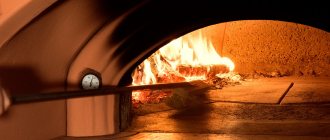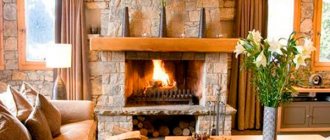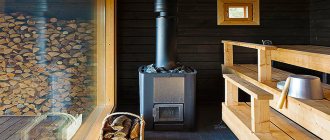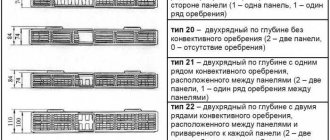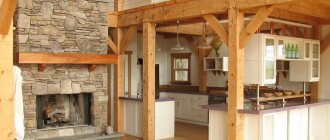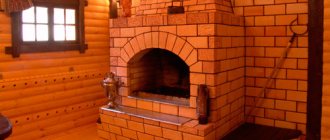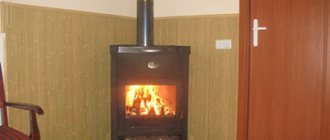Features and Benefits
Home fireplaces appeared in Russia in the 13th century, and replaced the stove in some houses. The fireplace was not only a heating structure, but also a luxurious decor. An open fire and crackling firewood create a homely atmosphere and a warm atmosphere. A fireplace, as a way of heating and decor, will easily fit into many interior styles: classic, modern, high-tech. With the help of a fireplace, you can zone the room and create a cozy corner for a family vacation.

Advantages and disadvantages of wood-burning fireplaces


Cast iron fireplace stove
Wood-burning stoves and fireplaces are of different types and designs, however, this does not prevent us from highlighting the common features of these heating systems. So, cast iron fireplace stoves working on wood have the following advantages:
- They do not need additional heat sources. In addition, they can be installed in the basement so that hot air rises to the upper floors;
- They run on economical and renewable fuel - wood;
- The wood-fired type fireplace stove absorbs all types of wood. Therefore, any dry twig can be used to heat a summer cottage;
- Very high efficiency.
- Wood-burning fireplaces are not without their disadvantages:
- Can cause fire if not properly operated. It is recommended to read the instructions before heating the house;
- You should always think about spare fuel;
- The wood takes too long to dry. On average, it takes about 12 months to fully dry;
- The operation of the fireplace stove must be monitored regularly;
- After firing, the device needs cleaning the ash pan. The chimney also requires a similar cleaning from time to time;
- A very high efficiency often turns into a disadvantage due to the fact that the room where the stove is located heats up to 40 degrees.
Which is better: brick or cast iron?
Cast iron... The design of a modern fireplace usually consists of a thick-walled firebox, a body and a chimney. Some models can be piped using a heat exchanger. This eliminates the need to connect central heating and purchase water heaters. The service life with constant use will be more than 15 years. It is worth choosing high-quality models with firmly installed parts and made of thick cast iron.
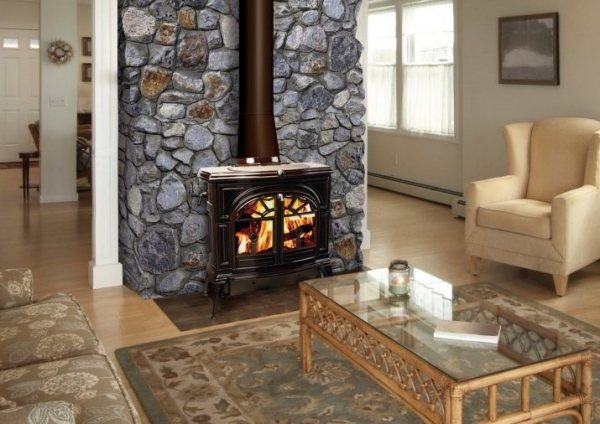

A durable cast iron fireplace will last a long time. The material can withstand the highest temperatures and is less susceptible to fading.


When exposed to high temperatures, the furnace structure does not deform.


Cast iron has a high heat transfer. After the wood in the fireplace burns out, cast iron will store and distribute heat for a long time, which allows heating large rooms and saves costs.


Many companies offer to buy a ready-made cast iron fireplace. Assembly and installation will not be difficult, but if you plan to install a heat exchanger, it is better to enlist the support of a specialist.


The cast iron stove option will not be as expensive as stone or brick models. The average model will cost 20-25 thousand rubles.
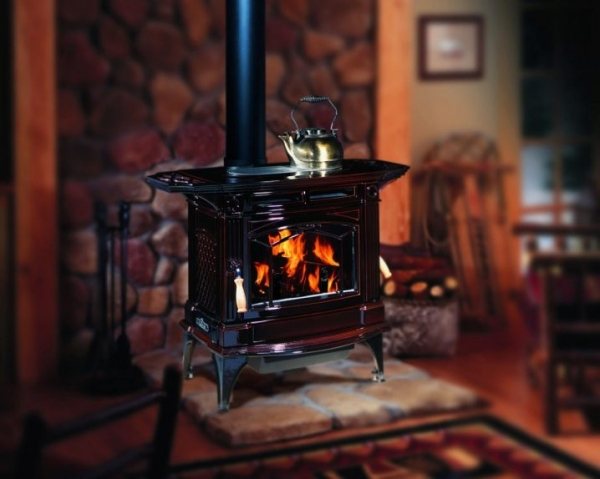

Do not sharply cool the cast iron stove, cold water, ice or snow can damage the material. Also, you do not need to hit the hot fireplace, from this it can burst.
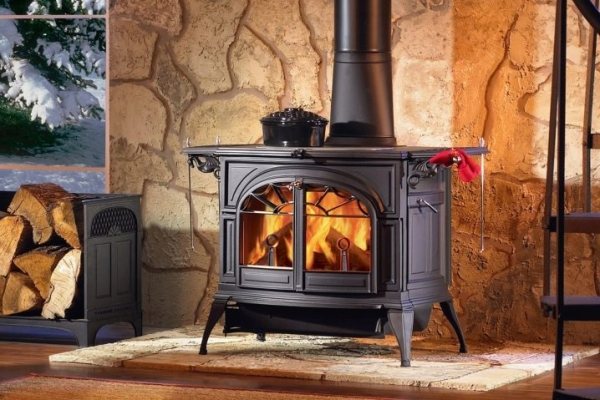

Regular and thorough care is required. All heavily contaminated parts of the fireplace: ash pan, chimney, must not be left unattended and must be cleaned regularly.


To many, this version of the fireplace seems unpresentable due to the black color and the simplicity of the material. But the cast iron stove can be ordered with any finish, the special paint does not undergo changes even due to the high temperature.


A brick oven is most often installed in country houses. The material allows you to build the structure yourself. With regular use, a brick fireplace will start to deteriorate after 5 years. Brick stoves allow you to quickly heat up the room even in the cold season.


The design is strong enough, resistant to sudden changes in temperature and humidity, which makes it less fragile.
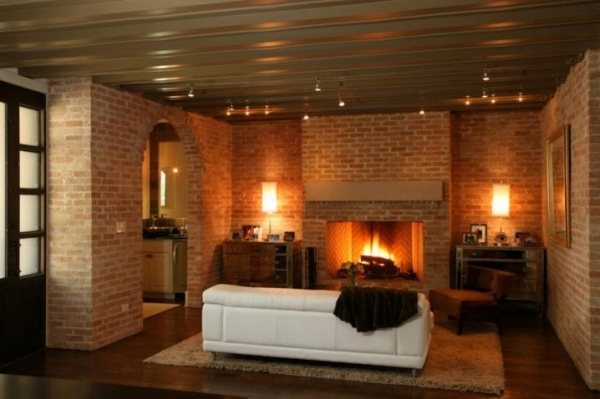

A real brick fireplace is quite easy to use, unlike cast iron, it does not need frequent cleaning.
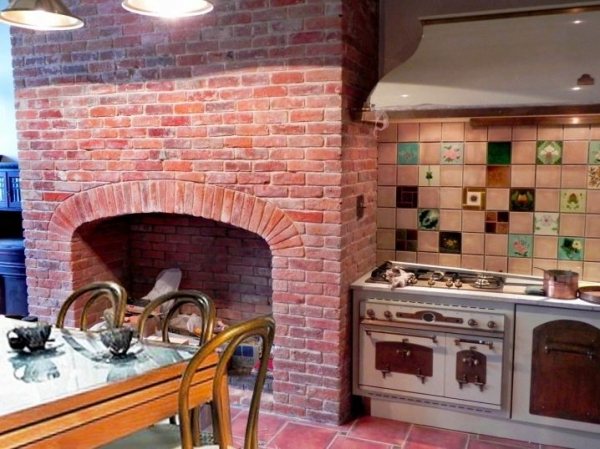

High-quality brick does not emit harmful substances and unpleasant odors when heated.
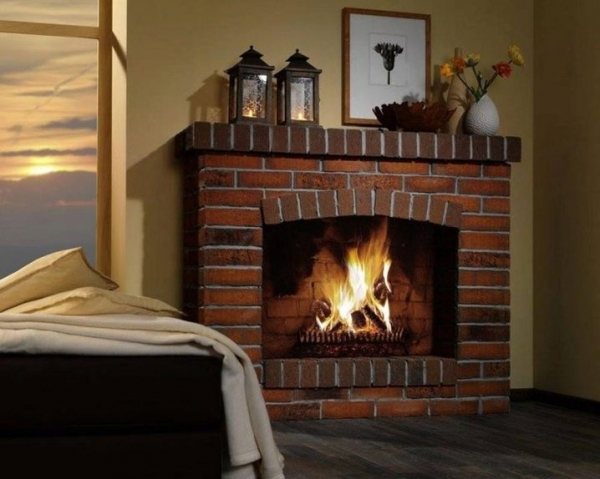

To lay out a brick fireplace yourself, you must have the appropriate experience and special tools, otherwise you need the help of a specialist stove-maker. Even minor installation errors can affect the good performance of the fireplace.


Quality brick is an expensive material. Also, costs are needed for the work of the stove, strengthening the floor and decorating.


Brick kilns are heavy enough and require a solid foundation to install.
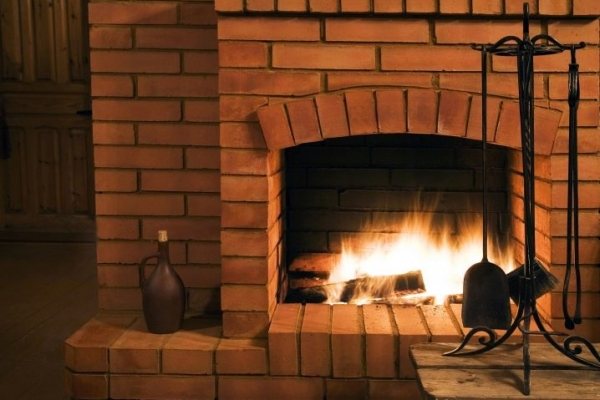

Installation on lower floors. It is difficult to install a brick fireplace in modern apartments. The partition between the floors may not support the weight, and the installation of the hood will have to be coordinated with a special authority.


Advantages and disadvantages of a metal hearth
It is possible to determine which of the fireplaces is better, taking into account the characteristic positive and negative aspects of operating the stoves. Among the advantages of a cast-iron hearth, the following qualities stand out:
- durability of the unit - cast iron walls withstand extremely high temperatures and burn out more slowly than furnaces made of other materials;
- the design does not change its shape when exposed to high temperatures;
- ease of installation, the possibility of buying a ready-made structure;
- ease of operation and maintenance;
- high heat transfer of metal makes it possible to heat large rooms and maintain a comfortable temperature for a long time after the furnace is turned off;
- low cost of a fireplace.
Many people believe that metal looks unpresentable in a modern interior. Dark cast iron does not harmonize well with a light interior, where plastic, wood, glass, tiles predominate. But this opinion is erroneous and refers to structures made by hand using, for example, a cast-iron bath.
A compact cast iron fireplace that matches any design, complementing the ambience. And if black material stops you, buy a stove with a white finish. Manufacturers cover fireplaces with special paint that does not crack or crumble when exposed to high temperatures. There are fewer disadvantages of cast iron stoves:
- hot cast iron is quite brittle. If you get on a hot material with cold water, or drop a heavy object, the stove may burst;
- it is impossible to leave the work of the hearth without attention. Regular maintenance is required: cleaning the ash pan and chimney;
- heavy weight requires several people to be installed.
Varieties of material
The modern market offers a wide selection of bricks: fireclay, clinker, etc. Basic requirements for bricks for laying fireplaces and stoves:
Resistant to temperature changes. Unsuitable bricks can crack or deform when suddenly cooled or heated, which leads to rapid wear of the fireplace.


Accumulation and retention of heat for a long time. In the cold season, it is important enough that the room heats up quickly, and the brick retains heat for a long time, even after the firewood stops burning.


What area are stoves and fireplaces designed for?
The power parameter of the heater affects its ability to heat a specific area of the room. An approximate calculation is 1 kW of the device per 1 m2 of room. This characteristic is obligatory for both stoves and fireplaces.
The heating capacity of fireplaces is usually low. Depending on the design of the furnace, chimney and model, such devices are designed for heating up to 40 - 80 m2. For heating a large house, it may be more rational to opt for stoves. These devices can have a heating power of up to 22 - 25 kW. These values are quite enough for high-quality heating of a 250 m2 house.
Recently, fireplace stoves have become very popular. Such hybrid devices combine the properties of one and the other designs: good power, decorative and elegant appearance, excellent view of the hearth.
Fireplace stoves are a good compromise in deciding which is better. The device combines the necessary qualities of both a fireplace and a stove.
The choice of a fireplace or stove should be based on practicality and functionality, the size of the room and the frequency of use of the appliance. That is why an unambiguous answer to the question: "What is better than a stove or fireplaces?", Can only be given by everyone for himself. Indeed, for some users, it is important to enjoy the burning of living fire. Others choose a full-fledged heating device.
Mechanical strength
Resistance to open fire. It is definitely worth checking the quality certificate, which indicates the main characteristics and properties of the material. For fireplaces and stoves, GOST 390-96 must be specified.


Fireclay bricks are made from special clay "fireclay" and some additives. Aluminum oxide gives the brick special strength and protection against environmental influences.


Clinker brick - has high strength and low moisture absorption. It can be used both for construction and for cladding. The color palette ranges from yellow to dark brown.
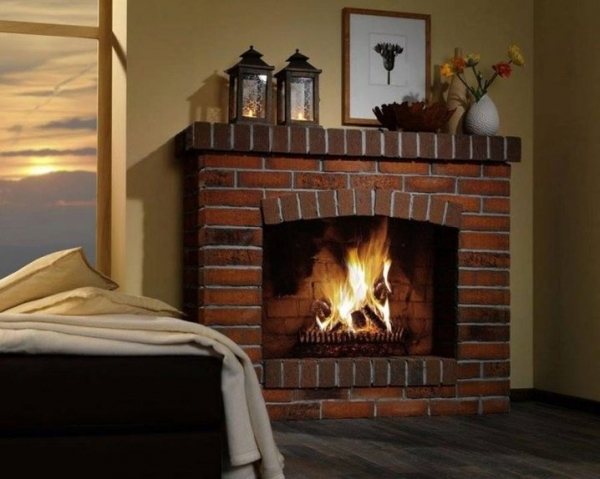

A special type of clay, "skinny", is mixed with various mineral additives, which gives the brick special strength and temperature resistance. Clinker bricks wear out less, and versions with a glazed surface do not absorb moisture at all (ordinary bricks absorb up to 25% moisture), which is especially important for outdoor fireplaces.


Periclase brick is expensive; rather rare minerals are used in its manufacture. But, at the same time, periclase brick has high refractoriness and is often used for the construction of fireplaces.


Figured bricks are used to decorate the fireplace. You can choose a different shape, texture and color. Do not forget that the facing material for the fireplace must have the same characteristics of strength and fire resistance. Sometimes, when facing, carved elements of ceramic bricks are used in the form of a triangle, arch, trapezoid and even a circle.


When choosing high-quality oven bricks, you should pay attention to the manufacturer's brand. One of the best firms producing facing and oven bricks is Lode. The Latvian company in the production uses high quality and environmentally friendly materials, follows modern technologies and trends. Thanks to a wide color palette, you can choose a brick for any interior: make a modern fireplace from light bricks or an old one from a material with an artificial antiquity effect.


The antique effect of the fireplace can be given by using hand-molded bricks in the masonry. There is no need to worry about the quality of such a brick, it has the same high strength properties. But, such material is quite high in terms of cost. The advantage of hand-molded bricks is not only in appearance, but also in environmental friendliness; in its manufacture, pure clay is used without impurities.


To obtain a unique texture and color, apply:
- Firing with the addition of special carbon powder.
- Secondary firing is carried out.
- Press through the mold with water.
- They are treated with colored sand.


Types of models
You can choose a brick fireplace by location, by the amount of space and functional preferences.Modern manufacturers provide a large selection of fireplace designs with various features: small outdoor, for a house or even an apartment.


By location, there are classic options for fireplaces: corner model, built-in, island.


The corner model is suitable for relatively small rooms and does not take up much space. Such a summer cottage mini fireplace is quite simple to manufacture, has good traction and a stable structure. Corner models quickly heat up and heat the room.


If you need to install a fireplace in an apartment, you should choose an external wall for the bookmark, but not next to the window, this will reduce the heating of the brick. It is necessary to coordinate the project with the construction and fire inspection, find out what kind of floors in the room, you may have to install an electric smoke exhauster in addition to the chimney.


In order not to risk and avoid unnecessary red tape, you can install a small false fireplace or an electric wall-mounted one. You can make a false brick-like fireplace with your own hands, and the fire will be replaced by wax candles of different shapes and heights.


An island fireplace is perfect for zoning a room, unlike a wall fireplace, it can be placed anywhere. This model is suitable for large rooms, because takes up a lot of space. The suspended chimney is not anchored to the wall and must be of a sufficiently strong, stable structure. The disadvantage of the island-type model is in low heat transfer, but this can be corrected by using high-quality bricks and additional decorative elements, they are also designed to retain heat.


The built-in version is the most compact. The chimney is laid inside the wall, and the portal protrudes from it by only half a brick. This option must be decorated with decorative material, it will keep warm and decorate the interior. Often, built-in models are complemented by an upper shelf; frames with photographs, graceful figurines or candles of different sizes and heights will perfectly fit on it.
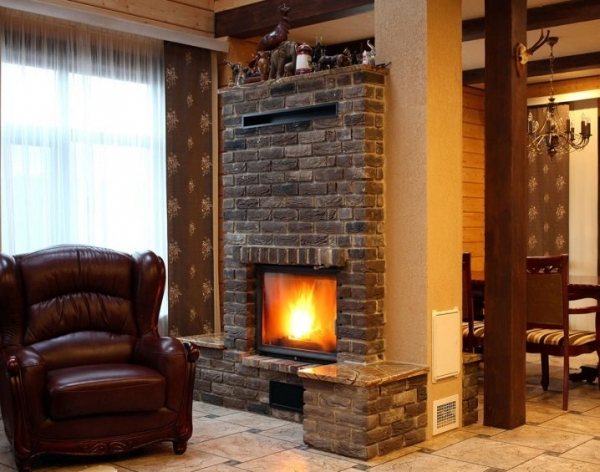

Open or closed?
Classic open fireplace option. There are models in which the fire is visible from one side, two, three or four. Corner and built-in design offers one-way opening, and island - two, three or four. An open fire will create a cozy atmosphere in the interior, but the more open sides, the less heating the room. Due to the lack of brick walls, the heat goes into the chimney, without lingering in the room, the brick fireplace acquires a more decorative function.
An open firebox is more functional, it is more often installed on the street. On an open fire, you can cook a barbecue, which eliminates the need to buy a barbecue. A classic English fireplace is always open, this gives the interior more comfort. Models made of old brick look especially impressive.


A closed firebox is safer than an open one; combustion takes place behind heat-resistant glass. The heat generated during combustion stays in the room longer. A plus is the ability to accurately control combustion up to several degrees, air is supplied using special mechanical levers, and not through an open space. A closed firebox, even with panoramic glazing, can be the main source of heat in the house and at the same time allows you to admire the fire. A glazed fireplace can be combined with a stove.


Features of metal furnaces
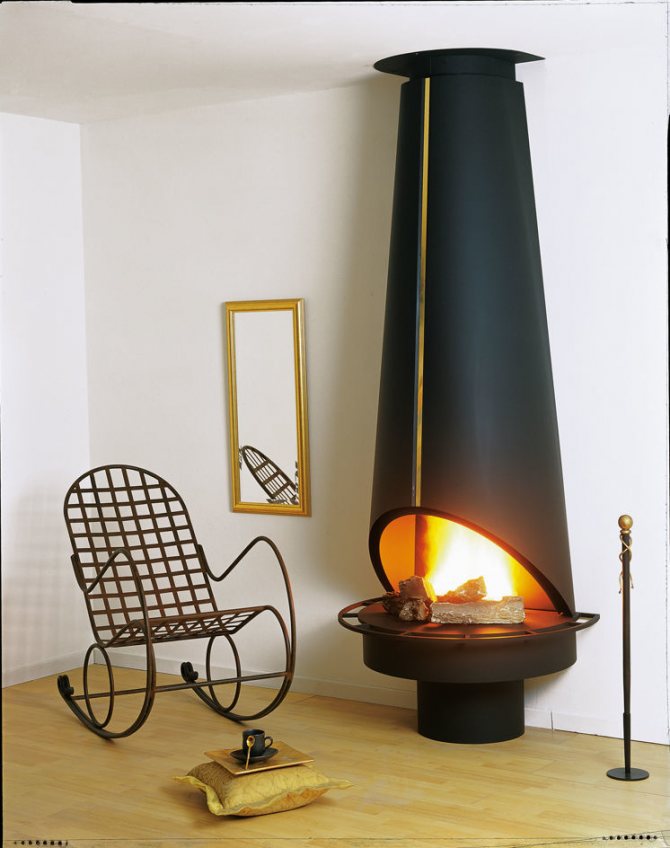

Metal fireplace
A cast iron fireplace is made almost entirely of cast iron. The material has a high heat transfer, due to which the stove quickly and evenly distributes heat in the house. The structure consists of a chimney, a body and a firebox with thick walls, which is closed by a transparent door with heat-resistant glass. Improved models are complemented by heat exchangers for the operation of hot water heating.
The cast iron stove is connected to a conventional chimney.Technically complex models require more painstaking work: connecting to a pipeline, creating a brick cushion, and pulling out a pipe. Simple fireplaces are better in terms of connectivity, but improved options open up more options, including getting hot water at any time of the year without connecting to a common water supply system and buying expensive heaters.
Fireplace stoves
The fireplace looks great in the interior, but it has a lot of heat loss, in order to avoid this, you can combine two designs - a stove and a fireplace.


The oven will allow the heat to stay in the room longer, and if you equip a special plane with a hob, you can cook without using a gas stove. A fire in the oven can provide sufficient temperature for heating and cooking food. This model is called "Swede" and is suitable for cooking, heating, storage of clothes. The hob is made of cast iron and can have several burners.


The fire in the fireplace stove can be open or closed. The closed design is more functional and takes up less space. The glazed firebox can be used as a stove and a fireplace at the same time. Such designs are more suitable for home interiors than outdoor interiors.


Kindling
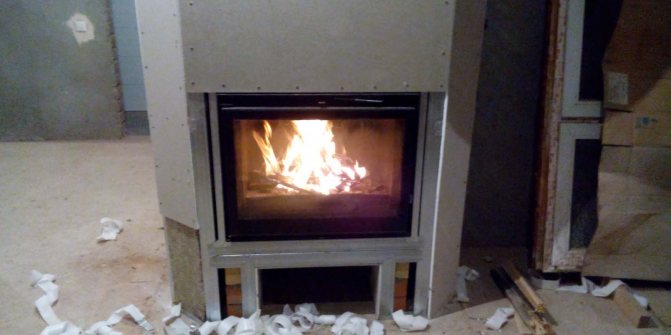

To many, this section may seem superfluous, because even a child can properly light the fireplace. And this is actually so, the problem can arise only during the first kindling, when the fireplace needs to be prepared and thoroughly warmed up. Only in this case it is possible to guarantee the high-quality operation of the device without unpleasant consequences.
First of all, you need to decide on what kind of fuel for the fireplace will be used. If this is firewood, then they must necessarily have a moisture content of no more than 20 percent, of course, this value is not critical, and it is absolutely not necessary to buy special devices for measuring moisture.
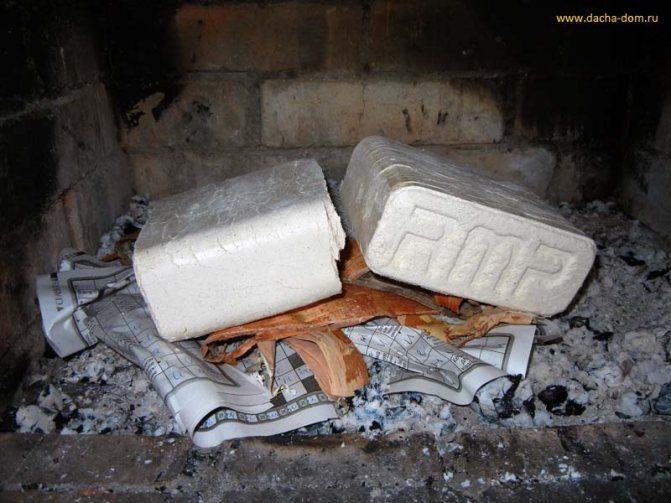

Just before placing the wood in the oven, it must be dried at room temperature for several weeks. If we talk about the type of wood, the firewood of which is used to heat the fireplace, then aspen or beech is best suited, since they have a high density, practically do not smoke and burn for a long time.
Fuel briquettes for the fireplace are a good alternative to wood; they initially have a high density and are completely free from moisture. As a result, much less plaque and soot forms on the walls of the furnace and inside the chimney, which interfere with the normal operation of the device.
Important! If you have multiple solid fuel devices installed, then heat the stove and the fireplace at the same time you only need the same types of combustible materials.
Device and design
The chimney is an important part of the fireplace design and has two options:
Straight design. The version with a direct chimney is installed directly at the time of construction of the building. Simplicity and versatility make the design convenient and widely used.


Inclined design. Convenient for reconstruction or renovation, it allows you to connect the chimney to ready-made channels.


The chimney can be with corners (rectangular, triangular) and made of brick, but experts recommend building a metal chimney with a smooth surface into it, this will help to avoid the formation of soot.


To improve heat transfer in the construction of the firebox, you can position its walls at a slight slope, and the installation of a special smoke chamber will protect the room from sparks and soot.


Also, to improve heating, you can additionally lay out a heating panel made of bricks, it will allow the heat to stay longer, which is very important in large rooms with fireplace heating.


The exterior design consists of a portal and cladding. The portal is the part that frames the firebox from the outside.Doors can be attached to the portal, in the event that the brick fireplace is of a closed type. A fireplace with a glass door gives a full view of the fire and is not much inferior to an open device.


You can also insert a door made of high-strength tempered glass with tinted glass, the fire behind it looks very nice and soft. Warm bronze tones will do, but cold graphite will look good in a modern interior.


In old houses, a coarse stove is often found. Such a stove can be converted into a fireplace, but it is worth contacting specialists. Overlapping rough under the fireplace is not an easy task, you need to assess the condition of the stove, carefully inspect the chimney and all other structures, check the masonry for cracks. A small stove door is not suitable for installing a fireplace, you can expand it or close the door and make it larger in another place.


If you plan to install a fireplace stove, you need two fireboxes and two chimneys, but such complications can be avoided if you install a fireplace with a heat-resistant glass door. This is a trick to keep it warm longer and you won't need an additional oven.


Stove or fireplace?
With all the abundance of heating devices, none of them has such an attractive force as fire. What to keep in mind when choosing a hearth for a summer residence and a country house?
FIREPLACE
A real fireplace will certainly decorate any country house. In addition, it is able to heat up the room very quickly. But, as a rule, not for long. Therefore, it will not replace full heating. When choosing a specific model of a fireplace, it is first of all important to understand what is the main purpose of its installation.
You want it to give warmth. Choose a fireplace with a closed type insert, and it is better if it is designed for frequent use. Furnaces of this type have self-cleaning refractory glass and high efficiency (which will allow you to economically use firewood).
The purpose is mainly decorative. Such fireplaces are also called interior fireplaces. A traditional open firebox (i.e. without glass) certainly looks more impressive.
But keep in mind that open fires require constant supervision. Screens and grilles, of course, protect from a "shot" coal or a log ineptly thrown by a child's hand, but it is impossible to give a full guarantee. There are other nuances as well. The speed of burning wood in an open fireplace is practically unregulated, it cannot be set to "slow" burning, so if you are determined to maintain a vigorous play of tongues of flame throughout the evening, you will need to stock up on a solid amount of dry wood.
BBQ fireplace. These fireplaces are usually open. And more often they are designed for outdoor installation (they are called outdoor fireplaces, grills). If you are going to cook kebabs in an ordinary fireplace, remember about the upcoming thorough cleaning of the furnace cavity and lining elements from the consequences of your cooking and be sure: if the firebox is with glass, it will also suffer from splashes.
IMPORTANT
The fireplace must not be placed in the path of possible drafts. But at the same time, it needs oxygen to maintain combustion. Therefore, it is better if the room with a fireplace is at least 20 meters.
The wall at which the fireplace is installed must be made of fireproof materials, and communications must not pass through it. If the wall is external, it is insulated with foil-covered basalt wool.
The weight of the assembled fireplace can be very heavy, so the floor underneath must have sufficient strength with the obligatory concrete screed. If you put a fireplace in a wooden panel house (where the floors are also made of wood) and it comes into contact with the wall, then you cannot make a separate foundation under the fireplace, since with separate movements of the foundations of the fireplace and the house, displacement of the wall can cause destruction of the fireplace itself. In this case, the wooden floor is reinforced with an iron profile.
BAKE
If you are not supposed to have other heating in your country house, you cannot do without a stove.The main difference between it and the fireplace is that the stove, although it takes a long time to heat up, but also retains heat for a long time.
Putting a real stone oven down is a difficult and responsible task, and you still need to find good craftsmen. It is much more convenient and simpler to purchase her younger sister - a household metal stove.
When choosing a model, consider the basic requirements for the oven:
1. The efficiency is not less than 75 - 85% (see the instructions) - otherwise you will go broke on firewood;
2. fire safety (see the corresponding certificate).
Also, make sure that you can fit the selected model into the desired room, taking into account the recommended parameters of the chimney and the distance to the wall.
IMPORTANT
The floor under the stove must not collapse. This means that it is necessary to prepare a foundation or concrete floors of sufficient strength, and the chimney according to the rules and in accordance with the requirements of the specific selected firebox.
The stove should be in the center of the house. In a house with a veranda, it is installed so that it faces the veranda, and the back and side walls are located between the internal partitions.
What is a fireplace stove
This, as the name suggests, is a cross between a household metal stove and a fireplace with a closed firebox. This design allows you to combine the advantages of a stove (keeps heat well) and a fireplace (quickly heats up the room). And if you choose the appropriate facing, it will not be inferior to the fireplace and in beauty.
IT'S PERFECT
The hearth is in the apartment!
Even the simplest fireplace or stove in a high-rise building is unlikely to be installed (although it is allowed to put stoves or fireplaces on the top floor of the building, you will have to go through many bureaucratic barriers to get this permission). But there is a way out: install an electric stove or fireplace. They are environmentally friendly, hygienic, safe, and their performance can be easily adjusted using a built-in or remote control panel. In addition, they can be turned off at any minute, the intensity of the "flame" can be set according to the mood, and the degree of heating - according to the level of comfort. True, such electric stoves / fireplaces have two significant drawbacks: high electricity consumption and low efficiency.
HOME NOTEBOOK
How to properly light the stove
1. Check that the valve on the pipe is open and the purge ports are closed.
2. Check the ash pan. There should not be too much ash (about an hour and a half after each furnace, it is necessary to rake and discard the cooled ash and ash, because if this is not done, corrosion will eat through metal, stone and brick).
3. Do not open windows and doors during firing up. And if the stove has not been heated for a long time, burn a few crumpled newspapers at the entrance to the chimney - this will "break through" the cold air at the entrance to the chimney.
4. Use only dry wood. It is better to heat the fireplace with hardwood. Conifers shoot sparks and coals. Take the logs thinner and drier, and fill the firebox no more than a quarter of the volume.
5. In the firebox, lay the first row of firewood across, the rest along, or you can lean them vertically against the far wall of the firebox. In fireplaces with an oven, wood can only be placed horizontally. Logs should not be pressed tightly to each other, otherwise the fire may "suffocate".
6. Carefully place birch bark or crumpled newspaper in the cracks between the woods, set them on fire and do not forget to close the doors and open the blower so that there is an optimal amount of air and good draft in the firebox.
7. The wood must burn with full fire. Insert new ones only after the previous bookmark has burned out more than half.
8. Avoid heating the oven too much. Listening to the fire and watching it will help you understand it.
9. Twice a year, be sure to clean the chimney from soot, soot and tar, which can cause a fire.
10. And, of course, do not leave a burning hearth unattended for a long time.
WHAT WHY
The price of a fireplace very much depends on the material from which it is made.Therefore, in each case, it is individual.
You can order a stone / brick fireplace or buy a ready-made fireplace (both open and closed), or you can simply buy a fireplace lining (portal), where you can then insert a wood-burning (open or closed) or electric firebox if you wish.
A fireplace cladding kit usually includes:
Passport products;
Assembly drawing;
installation instructions.
kp.ru
Styling
If all the preparatory work to strengthen the floor is completed (the floor must support the weight of the fireplace structure), schemes, plans and calculations have been drawn up, you can start laying a homemade fireplace.
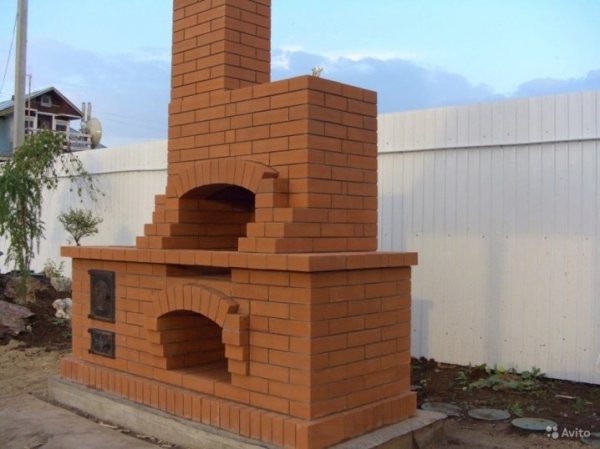

For laying any fireplace, you need bricks of different sizes: whole, half and quarter, this will help to avoid misalignment with the plan. The number of bricks, binder mass and other materials is strictly calculated before starting work.


It is worth laying home-made rows in strict accordance with the plan, there should be no differences and errors, you can use a level to check. The height of the joints for a red brick fireplace of standard sizes should not be more than 0.5 cm, the mortar must be laid out in the middle of the brick plane.
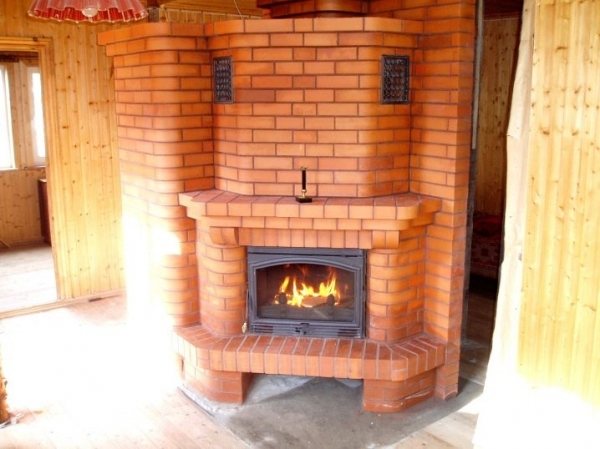

But, it is worth remembering that only a specialist stove-maker can perfectly lay out a fireplace or stove. You should not entrust the work to non-professionals or do the calculation yourself, especially if you have no experience. Such a design is not assembled quickly and requires a careful approach.


How to finish
There are several ways to frame brick facades with a built-in firebox:
Plaster is one of the simplest and most practical options. The modern composition allows you to plaster relief patterns or a simple smooth surface. Paint or decorative plaster can be applied on top.
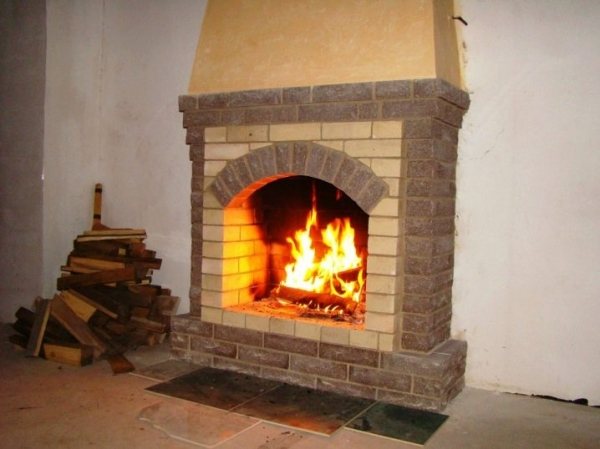

Painting is the easiest option. If you do not want to hide the relief of the bricks, it is enough to walk through 1-2 layers of paint, but you should choose the least toxic and durable samples. To make the paint lay flat, you can plaster the brick with a thin layer of finishing putty and only then paint it.


Facing with tiles or stone. The option is quite expensive and effective. In the modern market, there are more images, different in color, texture, size and pattern. The facing stone can be laid out in order, or in any other chaotic order. Tiling the facade of a fireplace is not so easy, it is tedious to find a good adhesive. The version with chipped tiles looks quite interesting, such a design is much easier to do, you just need to pick up pieces of suitable size and dock.
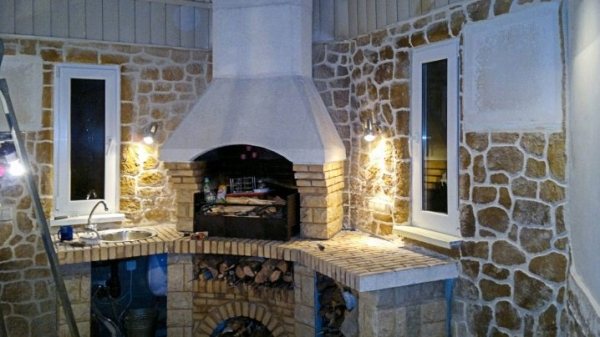

If we are building a closed fireplace, we make the cladding corresponding to the glass and partitions. Here the decoration will be the brick itself or ceramic tiles.


Color solutions
The color scheme of the fireplace should match the main interior. For the "loft" style, hand-molded bricks with an aging effect are suitable. For a classic interior in beige tones - light yellow brick.


Modern colorful coatings and putties can withstand high temperatures and are easy to clean, this makes it possible to paint the fireplace in any color.


The cost
It is an expensive pleasure to lay out a fireplace made of high-quality material: prices vary, but generally the cost is 2-3 times more expensive than a cast-iron stove.
The manufacture of heat-resistant bricks is a costly and time-consuming process: it is necessary to harden the brick at the highest temperature, select high-quality clay, and get rid of harmful additives. How much the masonry will cost depends on the work of the stove-maker, strengthening the floor, the cost of bricks and bonding materials, on average - 50 tons.


Advantages and disadvantages of brick ovens
The advantages of a brick fireplace include the following qualities:
- high heat capacity, which allows heating rooms without additional equipment;
- fast heating even in winter in an unheated house;
- strength and durability, resistance to temperature and humidity changes;
- ease of use.
Aesthetic properties are achieved thanks to a well-chosen order for laying the fireplace. A brick fireplace can be decorated with stone, tiles and plaster. But this is not necessary - if the work is done carefully, the seams are smooth, then the finished structure does not disappoint with its appearance.
There are also disadvantages to the fireplace:
- high cost of material and the work of stove-makers;
- time-consuming process of laying a fireplace;
- heavy weight of the structure, requiring floor reinforcement or additional foundation.
Brick hearths are suitable for private houses and summer cottages. It is unprofitable and dangerous to install them in apartments - the partition between the floors may not support the weight of the fireplace.
Repair and maintenance
The fireplace needs regular maintenance: it is necessary to periodically clean up the ash pan and clean it. The chimney should be cleaned three times a year, as recommended by experts. You can invite a chimney sweep or do it yourself.


Restoration of brick fireplaces is a complex and costly process, it is easier to clean the structure once a season than to contact a master and waste precious time and money.


Interesting solutions in interior design
An interesting solution would be to install an island fireplace directly in the wall. A not wide brick wall is installed in the middle of the room, and a hole for a fireplace is made in the middle. The flame will be visible from all four sides, but it is worth taking care of the strength of the structure: install metal pins in the corners of the wall and line them with square bricks. The upper part of the wall will serve as a place for the chimney. Such a solution will be interesting in both open and closed versions.


Another option is an interesting cladding. At the time of Peter I, it was fashionable to install stoves with Dutch tiles with pastoral drawings with cobalt paint in rooms. Such a stove will decorate the interior and make you spend hours looking at the drawings against the background of small tiles. In a spacious apartment, such a solution is quite appropriate.







